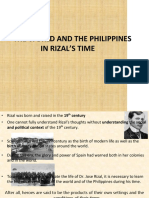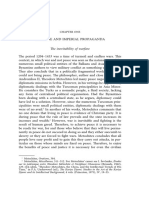0 ratings0% found this document useful (0 votes)
3 views19th Century
19th Century
Uploaded by
5pn4x4czxnThe document discusses key events and policies in 19th century Philippines including the opening of the Suez Canal, the administration of Carlos Maria De La Torre, the tyrannical regime of Rafael de Izquierdo, the issue of secularization, the Cavite Mutiny from Spanish and Filipino perspectives, the execution of Gomburza which became a rallying cry, and unjust Spanish policies such as polo y servicios and lack of representation in the Spanish Cortes.
Copyright:
© All Rights Reserved
Available Formats
Download as PPTX, PDF, TXT or read online from Scribd
19th Century
19th Century
Uploaded by
5pn4x4czxn0 ratings0% found this document useful (0 votes)
3 views22 pagesThe document discusses key events and policies in 19th century Philippines including the opening of the Suez Canal, the administration of Carlos Maria De La Torre, the tyrannical regime of Rafael de Izquierdo, the issue of secularization, the Cavite Mutiny from Spanish and Filipino perspectives, the execution of Gomburza which became a rallying cry, and unjust Spanish policies such as polo y servicios and lack of representation in the Spanish Cortes.
Original Description:
Donebsbanabahsjsjdjjddifiifififjfhdhdjskwwoejrjjdosososidjfifidoeododk
Copyright
© © All Rights Reserved
Available Formats
PPTX, PDF, TXT or read online from Scribd
Share this document
Did you find this document useful?
Is this content inappropriate?
The document discusses key events and policies in 19th century Philippines including the opening of the Suez Canal, the administration of Carlos Maria De La Torre, the tyrannical regime of Rafael de Izquierdo, the issue of secularization, the Cavite Mutiny from Spanish and Filipino perspectives, the execution of Gomburza which became a rallying cry, and unjust Spanish policies such as polo y servicios and lack of representation in the Spanish Cortes.
Copyright:
© All Rights Reserved
Available Formats
Download as PPTX, PDF, TXT or read online from Scribd
Download as pptx, pdf, or txt
0 ratings0% found this document useful (0 votes)
3 views22 pages19th Century
19th Century
Uploaded by
5pn4x4czxnThe document discusses key events and policies in 19th century Philippines including the opening of the Suez Canal, the administration of Carlos Maria De La Torre, the tyrannical regime of Rafael de Izquierdo, the issue of secularization, the Cavite Mutiny from Spanish and Filipino perspectives, the execution of Gomburza which became a rallying cry, and unjust Spanish policies such as polo y servicios and lack of representation in the Spanish Cortes.
Copyright:
© All Rights Reserved
Available Formats
Download as PPTX, PDF, TXT or read online from Scribd
Download as pptx, pdf, or txt
You are on page 1of 22
19 Century Philippines
th
• Maria Bernadette M. Macadaeg
• Instructor 1
• mbmacadaeg@mmsu.edu.ph
COLLEGE OF ARTS & SCIENCES Department of Social Sciences
Objectives
• Appraise the link between the individual and the society;
• Analyze the various social, economic, political, and cultural changes
that occurred in the 19th century Philippines; and
• Understand Jose Rizal in the context of his time.
COLLEGE OF ARTS & SCIENCES Department of Social Sciences
The Rise of Liberalism in
Spain and the Philippines
The Opening of the Suez Canal
• November 17, 1869 – Ferdinand de
Lesseps who made the Suez Canal
• Connecting the Red sea and
Mediterranean sea (Asia to Europe)
• Travel from Europe to Philippines was
reduced from 3 months to 32 days
• Trade flourished
• Prompted the influx of foreign
newspapers and books that catapulted
the Philippines to a new age.
The Administration of Carlos Maria De La
Torre
• He was a liberal-minded governor-general
in the Philippines.
• He encouraged the Filipinos to participate
in the government and expressed their
sentiments for the development of his
administration.
• He established the Guardia Civil in the
Philippines and give amnesty to rebels.
• He allowed freedom of speech.
• Opened Malacanang to the people on July
12, 1869.
• Was replaced by Rafael de Izquierdo
Tyrannical regime of Izquierdo
• Famous for his use of iron fist
• Re-imposed censorship
• Banned all talks of reform and liberty
• Stop the Filipinization of parishes in
the country
• Revoked the exemptions of Filipino
on forced labor and tributes
The Issue of Secularization
• It started in the times of Archbishop
Sta. Justa and Gov. Gen. Anda.
• The Filipino priests were appointed to
head vacant churches.
• Secular priest are Filipino priest
• Regular priests are Spanish priest who
belonged to religious orders such as
Augustinians, Recollects, Dominicans
etc
• Religious orders opposed the plan for
they believed that the Filipinos are
not worthy to be Friar Curate
• Msgr Pedro Pelaez – Ecclesiastical
governor of the church who believed
that Filipinos should be given the
chance to serve
• Father Jose Burgos continued the
fight after the death of Msgr Pelaez
The Two Faces of the Cavite Mutiny – Spanish
Perspective
• Jose Montero y Vidal, a prolific Spanish
historian documented the event and highlighted
it as an attempt of the Indios to overthrow the
Spanish government in the Philippines.
• Gov. Gen. Rafael Izquierdo’s official report
magnified the event and made use of it to
implicate the native clergy, which was then
active in the call for secularization.
• He reported to the King of Spain that the
“rebels” wanted to overthrow the Spanish
government to install a new “hari” in the likes
of Fathers Burgos and Zamora.
The Two Faces of the Cavite Mutiny – Spanish
Perspective
• The two Spaniards deemed that the event
of 1872 was planned earlier and was
thought of it as a big conspiracy among
educated leaders, mestizos, abogadillos
or native lawyers, residents of Manila
and Cavite and the native clergy.
• Sergeant Lamadrid together with 200
soldiers launched an attack targeting
Spanish officers at sight and seized the
arsenal.
The Two Faces of the Cavite Mutiny – Spanish
Perspective
• Sergeant Lamadrid was killed in the skirmish, while
the GOMBURZA were tried by a court-martial and
were sentenced to die by strangulation.
• Patriots like Joaquin Pardo de Tavera, Antonio Ma.
Regidor, Jose and Pio Basa and other abogadillos
were suspended by the Audencia (High Court) from
the practice of law, arrested and were sentenced with
life imprisonment at the Marianas Island.
• Gov. Izquierdo dissolved the native regiments of
artillery and ordered the creation of artillery force to
be composed exclusively of the Peninsulares.
A Response to Injustice: The Filipino Version of
the Incident
• Dr. Trinidad Hermenigildo Pardo de
Tavera, a Filipino scholar and
researcher, wrote the Filipino version of
the bloody incident in Cavite.
• The incident was a mere mutiny by the
native Filipino soldiers and laborers of
the Cavite arsenal who turned out to be
dissatisfied with the abolition of their
privileges.
A Response to Injustice: The Filipino Version of
the Incident
• Tavera believed that the Spanish friars and
Izquierdo used the Cavite Mutiny as a
powerful lever by magnifying it as a full-
blown conspiracy.
• The Central Government of Spain instill
reforms in the Philippines like the Moret
decree.
• Tavera sadly confirmed that the Madrid
government came to believe that the
scheme was true without any attempt to
investigate the real facts or extent of the
alleged “revolution” reported by Izquierdo
and the friars.
The Execution of Gomburza
• Father Mariano Gomez – head priest
of Bacoor, the second richest parish in
Cavite in terms of tributes collected.
• He served for forty eight years and was
loved by the people.
• He helped to collect funds for
representative to be sent in Rome for
the secularization.
• He became part of the list of the friars
that they wanted to eliminate.
The Execution of Gomburza
• Father Jacinto Zamora – head priest of
Marikina.
• He was also part of the secularization
movement and supported the struggle of the
Filipino priest for equality and opportunity
to lead a church.
• Father Jose Burgos – the friend of Paciano.
• He became the leader of the secularization
movement.
• He wrote essays which contradicted the
regulars
The Execution of Gomburza
• Francisco Zaldua – witness against
GOMBURZA
• Claimed that he was the messenger of
Burgos
• February 17, 1872 - garroted
• Archbishop Greogorio Meliton
Martinez – wanted the church bells to
be played upon the execution as a
respect to the priests
Significance of their Death
• National consciousness emerged
• It became the battle cry for the Propaganda movement
• The Katipunan use the word GOMBURZA as password
• The Katipunan declared Feb 17 as commemorative day of prayer
• El Filibusterismo was dedicated to the priests
The Implementation of Different Unjust
Policies
• Polo y servicios
• Encomienda
• Hacienda owned by
the Friars
• Bandala
• Tributo
Lack of Representative in the Spanish
Cortes
• Cadiz Constitution which
allows a representative for
every colony
• Ventura de los Reyes – 1st
representative of the
Philippines
• Representation was one of the
reform Rizal wanted
Post Activity Socio-Drama
• Form group of 6 -7 members
• The group will be given 20 minutes to develop their
script and practice their action for the socio-drama. The
script should have Spanish policy and possible reactions
of the Filipinos in the context of 19 th century.
Get in Touch
With Us
Send us a message or
visit us
City of Batac, Ilocos Norte,
Philippines
(63) 77-600-0459
op@mmsu.edu.ph
Follow us for updates
facebook.com/MMSUofficial
www.mmsu.edu.ph
You might also like
- Year 7 English War HorseDocument1 pageYear 7 English War HorsePepa100% (1)
- Controversies and Conflicting Views in Philippine HistoryDocument24 pagesControversies and Conflicting Views in Philippine HistoryRomalie Fullo GalletoNo ratings yet
- Cavite MutinyDocument39 pagesCavite MutinyAnonymous CVCFjlf100% (3)
- Group 5: Matin-Ao, John Dale Misa, Philbert Montecillo, Clarissa Muit, LykahDocument27 pagesGroup 5: Matin-Ao, John Dale Misa, Philbert Montecillo, Clarissa Muit, LykahBeverly Kate LopezNo ratings yet
- Module 5 Learning Activity 1Document20 pagesModule 5 Learning Activity 1Angela Beatrice100% (1)
- Gomburza and The Cavite Mutinee: Handout 4 FDocument23 pagesGomburza and The Cavite Mutinee: Handout 4 FKyleRhayneDiazCaliwagNo ratings yet
- Secularization WPS OfficeDocument5 pagesSecularization WPS OfficeJasmin MasaNo ratings yet
- Cavite Mutiny Group1Document37 pagesCavite Mutiny Group1seith panizaNo ratings yet
- CFLM Lesson 1 MidtermsDocument38 pagesCFLM Lesson 1 MidtermsSchultNo ratings yet
- The World and The Philippines in Rizal'S TimeDocument21 pagesThe World and The Philippines in Rizal'S TimeDJ Free Music100% (3)
- The SecularizationDocument16 pagesThe SecularizationmiraeNo ratings yet
- History 7-WPS OfficeDocument3 pagesHistory 7-WPS OfficejugadordarlynjebNo ratings yet
- Cavite MutinyDocument30 pagesCavite Mutinysheena bertolanoNo ratings yet
- Cavite MutinyDocument16 pagesCavite MutinyNadihs BrimonNo ratings yet
- MIDTERM 2.the Two Faces of Cavite MutinyDocument18 pagesMIDTERM 2.the Two Faces of Cavite Mutinykleng BaliscaoNo ratings yet
- RIZAL. The Rise of Phil - NationalismDocument19 pagesRIZAL. The Rise of Phil - NationalismAbdulbasit MagomparaNo ratings yet
- Emerging Nationalism Part 1Document3 pagesEmerging Nationalism Part 1MATCHA motoNo ratings yet
- Cavite MutinyDocument29 pagesCavite MutinyBen Cyrus PangapalanNo ratings yet
- Secularization ControversyDocument3 pagesSecularization ControversyIsabel FlonascaNo ratings yet
- Frailocracy As A Social CancerDocument37 pagesFrailocracy As A Social CancerRed ConvocarNo ratings yet
- 1872 Cavite Mutiny: Convicted Educated Men Who Participated in The Mutiny Were Sentenced Life ImprisonmentDocument2 pages1872 Cavite Mutiny: Convicted Educated Men Who Participated in The Mutiny Were Sentenced Life ImprisonmentGuilliane GallanoNo ratings yet
- Readings IN Philippine HistoryDocument21 pagesReadings IN Philippine HistoryGertrude AbeledaNo ratings yet
- 1896 Philippine Revolution MKJGDocument36 pages1896 Philippine Revolution MKJGLove Amihra Jeanskyn AgnirNo ratings yet
- RI ZA L: Seculirization To Filipinization of ParishesDocument18 pagesRI ZA L: Seculirization To Filipinization of ParishesDexter AcopiadoNo ratings yet
- Emerging NationalismDocument3 pagesEmerging NationalismMATCHA motoNo ratings yet
- 006 The Propaganda MovementDocument28 pages006 The Propaganda MovementJason CuregNo ratings yet
- 3.3 Rise of Filipino NationalismDocument35 pages3.3 Rise of Filipino NationalismmaricrisandemNo ratings yet
- Development of Philippine Nationalism and PatriotismDocument2 pagesDevelopment of Philippine Nationalism and PatriotismJoanna Jopay M. LuayonNo ratings yet
- GCmajorshiplecture GC PDFDocument229 pagesGCmajorshiplecture GC PDFEra100% (1)
- Lecture 2 Rise of LiberalismDocument22 pagesLecture 2 Rise of LiberalismAbvic Ryan MaghirangNo ratings yet
- The Two Faces of 1872 Cavite Mutin Y: By: Chris Antonette Piedad-PugayDocument28 pagesThe Two Faces of 1872 Cavite Mutin Y: By: Chris Antonette Piedad-Pugaykiko pangilinanNo ratings yet
- Lesson 2-3 RizalDocument33 pagesLesson 2-3 RizalZaira PanganibanNo ratings yet
- The Philippines Under SpainDocument59 pagesThe Philippines Under SpainAkshit VarshneyNo ratings yet
- (G2-PH History) Propaganda Movement and American RevolutionDocument189 pages(G2-PH History) Propaganda Movement and American Revolutiongriefer wildNo ratings yet
- 03 Chapter 3-Rise of Filipino Nationalism-2nd SemDocument44 pages03 Chapter 3-Rise of Filipino Nationalism-2nd SemMicheleNo ratings yet
- Filipino' S OF Cavite Mutiny OF 1872Document18 pagesFilipino' S OF Cavite Mutiny OF 1872Sunshine ArceoNo ratings yet
- Document 14Document4 pagesDocument 14Viper VixenNo ratings yet
- Cavity MutinyDocument18 pagesCavity Mutinyvalbularin11No ratings yet
- Cavite Mutiny 1872 1Document46 pagesCavite Mutiny 1872 1Jenriel BaconawaNo ratings yet
- RIZALITIANOLISMDocument13 pagesRIZALITIANOLISMJ and J VlogNo ratings yet
- For Majorship With Answer KeyDocument349 pagesFor Majorship With Answer KeyannNo ratings yet
- Injustice Response - Filipino VersionDocument36 pagesInjustice Response - Filipino VersionKennethEdiza100% (4)
- AAAAADocument9 pagesAAAAAAira May CoronelNo ratings yet
- Group-3-GECREA 20241020 004345 0000Document18 pagesGroup-3-GECREA 20241020 004345 0000staanajoyann30No ratings yet
- Document 2Document17 pagesDocument 2Angela May Gamutan100% (1)
- I Am Sharing 'Social Studies 3rd Topic' With You PDFDocument10 pagesI Am Sharing 'Social Studies 3rd Topic' With You PDFJohn Joseph RicaNo ratings yet
- Bleeee 20240715 031544 0000Document27 pagesBleeee 20240715 031544 0000danicamaeanting6No ratings yet
- The Propaganda Movement and The KatipunanDocument12 pagesThe Propaganda Movement and The KatipunanChristian Dave MativoNo ratings yet
- Cavite MutinyDocument23 pagesCavite Mutinyvaldezjohndavid5No ratings yet
- Lesson 11 1 Rizals Second Homecoming and The La Liga FilipinaDocument35 pagesLesson 11 1 Rizals Second Homecoming and The La Liga FilipinaLUISA MARIE DELA CRUZNo ratings yet
- Summarization Chapter 7Document11 pagesSummarization Chapter 7Maestro Jay0% (1)
- For The Colonial JusticeDocument17 pagesFor The Colonial JusticeMikhaela GonzalesNo ratings yet
- Hist ReportDocument28 pagesHist ReportKristy Dela CernaNo ratings yet
- The Propaganda Movement and The KatipunanDocument45 pagesThe Propaganda Movement and The KatipunanAdam Robert LidoNo ratings yet
- APznzaYK5q7hslrlqiwuTGyBhzsURKpufuulecsNvWKYbQC1sq61TZ8iH0MDbpEbkNiODWogf ApeMsq1aw9EO6TkmPUoe0klLUcyxVa0q71mPii2oPohklubz9 YGRf1atbv5g D38QdPmXC2juvklpecIQFMD3mqRpjvYVwCGiIAQHd6SJdyHKHWgsZDMn7OX9TMgfI4Waw E6CvbotbhDocument48 pagesAPznzaYK5q7hslrlqiwuTGyBhzsURKpufuulecsNvWKYbQC1sq61TZ8iH0MDbpEbkNiODWogf ApeMsq1aw9EO6TkmPUoe0klLUcyxVa0q71mPii2oPohklubz9 YGRf1atbv5g D38QdPmXC2juvklpecIQFMD3mqRpjvYVwCGiIAQHd6SJdyHKHWgsZDMn7OX9TMgfI4Waw E6CvbotbhchrisNo ratings yet
- What Is Cavite Mutiny?Document2 pagesWhat Is Cavite Mutiny?Generose Camu100% (1)
- GE 2 PPT Cavite-MutinyDocument26 pagesGE 2 PPT Cavite-MutinyIrene NoeNo ratings yet
- 3.3 Emerging NationalismDocument2 pages3.3 Emerging NationalismSalarda KesterNo ratings yet
- Friars and Filipinos An Abridged Translation of Dr. Jose Rizal's Tagalog Novel, 'Noli Me Tangere.'From EverandFriars and Filipinos An Abridged Translation of Dr. Jose Rizal's Tagalog Novel, 'Noli Me Tangere.'No ratings yet
- 2018 05 15 Lithuanian HeritageDocument36 pages2018 05 15 Lithuanian HeritageJohn NekusNo ratings yet
- The 1965 American Sale of Tanks To IsraelDocument15 pagesThe 1965 American Sale of Tanks To IsraelGiora MinorNo ratings yet
- Orc War HordesDocument10 pagesOrc War HordesErica Field0% (1)
- Relic HelmetsDocument6 pagesRelic HelmetsKleverton MoisesNo ratings yet
- Construction Claims & Contracting StrategiesDocument10 pagesConstruction Claims & Contracting StrategiesKen WongNo ratings yet
- Final Coaching LEADocument50 pagesFinal Coaching LEARon Mols Andawa100% (1)
- HISTORY - WWII - Holodomor & White Genocide - Why Did Hitler Invade Poland - (13 Pag)Document13 pagesHISTORY - WWII - Holodomor & White Genocide - Why Did Hitler Invade Poland - (13 Pag)José Luis RuizNo ratings yet
- Citizens United Department of Defense FOIA Request (March 29, 2021)Document1 pageCitizens United Department of Defense FOIA Request (March 29, 2021)Citizens UnitedNo ratings yet
- REVOLTSDocument11 pagesREVOLTSVenz Lei Collyn Atis EsinNo ratings yet
- Emilio Aguinaldo and Philippine RevolutionDocument2 pagesEmilio Aguinaldo and Philippine RevolutionJhevelyn PagtalunanNo ratings yet
- CDT Priti Puja Pradhan. Od-19-Sw-A-304-334. The Role of NCC in Covid-19Document4 pagesCDT Priti Puja Pradhan. Od-19-Sw-A-304-334. The Role of NCC in Covid-19Ē Vì LNo ratings yet
- The Tactical Attitude and The Military Feeling: Stock Caliber DimensionsDocument2 pagesThe Tactical Attitude and The Military Feeling: Stock Caliber Dimensions董伟清No ratings yet
- Learning EvidenceDocument5 pagesLearning EvidenceShaneil MatulaNo ratings yet
- New PO3 ChecklistDocument2 pagesNew PO3 ChecklistAnonymous msi2GBtWfsNo ratings yet
- All Demolition AddressesDocument16 pagesAll Demolition AddressesGazetteonlineNo ratings yet
- Lista de Precio Aptg 24-10-23Document148 pagesLista de Precio Aptg 24-10-23oswaldo8072No ratings yet
- Some Pages From The History Book of The NirmalDocument12 pagesSome Pages From The History Book of The NirmalMohammed Abdul Hafeez, B.Com., Hyderabad, IndiaNo ratings yet
- Gayatri Sahasranama StotramDocument36 pagesGayatri Sahasranama StotramRahul DocNo ratings yet
- All India Sarkari JobsDocument9 pagesAll India Sarkari JobsSHAIK WASEEM AKRAM.No ratings yet
- Lea 101 S1Document24 pagesLea 101 S1Din Flores MacawiliNo ratings yet
- AFV Modeller - Issue 17 - 3 - SDKFZ 250 Mit 5cm PakDocument8 pagesAFV Modeller - Issue 17 - 3 - SDKFZ 250 Mit 5cm PakJosé Carlos Barros Dopaso100% (1)
- Beer Hall Putsch and Landsberg PrisonDocument2 pagesBeer Hall Putsch and Landsberg PrisonBilly Frankovick100% (1)
- Caladius Grav TankDocument1 pageCaladius Grav TankOliver AsmussenNo ratings yet
- Issb G.K 1Document28 pagesIssb G.K 1Muhammad AzamNo ratings yet
- Doom: The Board Game - Solo Variant - AI Invader: SetupDocument4 pagesDoom: The Board Game - Solo Variant - AI Invader: SetupBelekeNo ratings yet
- Ada 289122Document115 pagesAda 289122decayonsiteNo ratings yet
- Prince Philip, Duke of Edinburgh (Born Prince Philip of Greece and DenmarkDocument20 pagesPrince Philip, Duke of Edinburgh (Born Prince Philip of Greece and DenmarkOxony19No ratings yet
- Warfare and Imperial PropagandaDocument32 pagesWarfare and Imperial PropagandaborjaNo ratings yet
- Readings in Philippine History MIDex-LRDocument5 pagesReadings in Philippine History MIDex-LRAudreyNo ratings yet

























































































